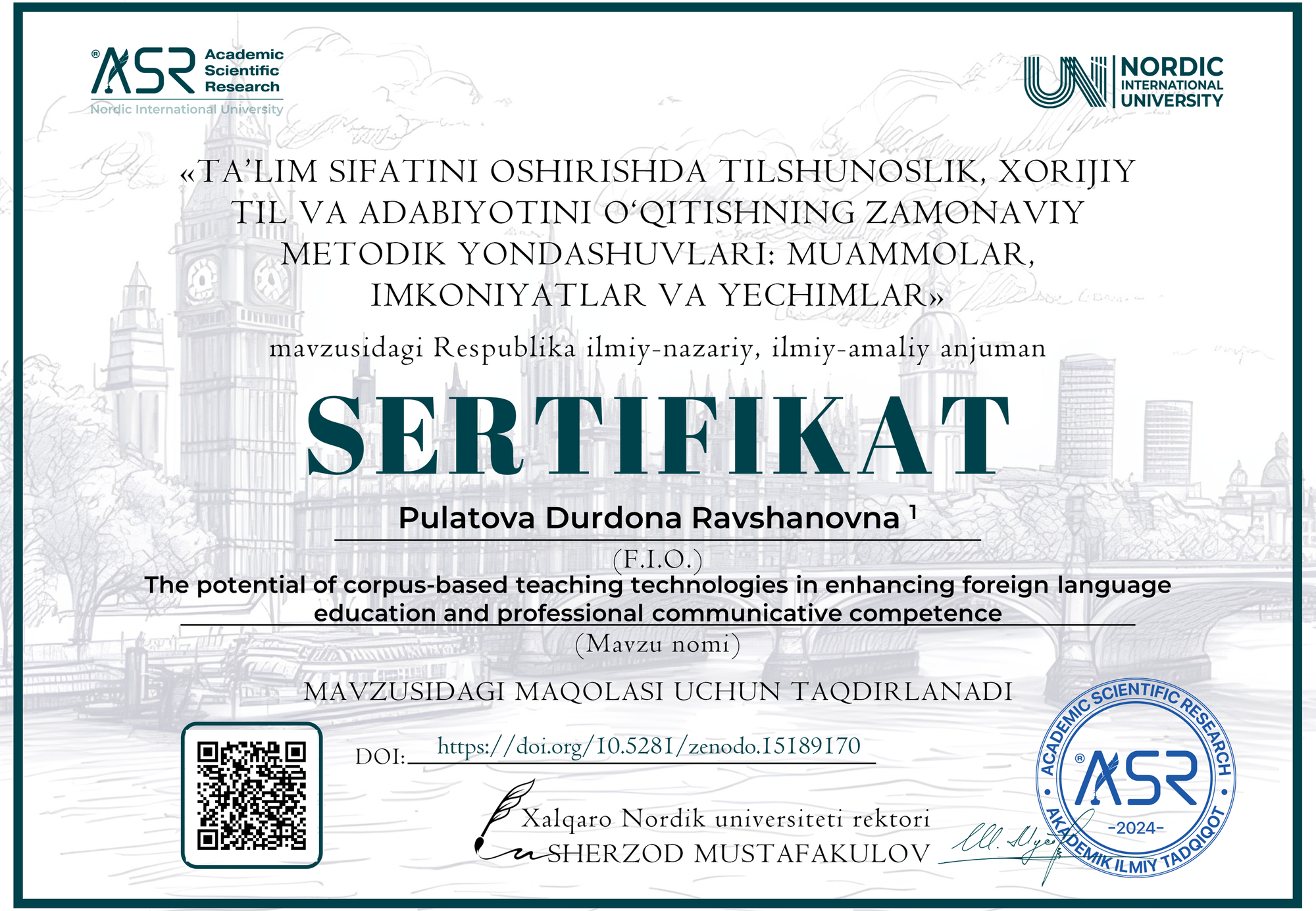Pulatova Durdona Ravshanovna 1

DOI: https://doi.org/10.5281/zenodo.15189170
Zenodo community: https://zenodo.org/records/15189170
Nordic_press journal: https://research.nordicuniversity.org/index.php/nordic/article/view/2306
MAQOLANI YUKLAB OLISH
SERTIFIKATNI YUKLAB OLISH
REVIEW:
In her article, Durdona Ravshanovna Pulatova investigates the integration of corpus-based teaching technologies in foreign language instruction, highlighting their potential to enhance both professional competence and communicative skills. The study addresses the significance of using authentic language data from digital corpora, processed through advanced software tools such as AntConc, Sketch Engine, Voyant Tools, and SKELL, in the development of pre-service teachers’ linguistic and pedagogical abilities.
The article provides a comprehensive examination of the key corpus tools that have gained popularity in language education. Pulatova explains how these tools allow educators to analyze frequent linguistic patterns, collocations, grammatical structures, and vocabulary usage, thus providing a more contextually rich learning experience. This method is particularly effective for building professional communicative competence, which involves using language accurately and appropriately in professional and academic settings.
A strength of the article is its clear and well-structured presentation of various corpus tools. For instance, AntConc is noted for its ability to provide concordance lines and keyword dispersion analysis, while Sketch Engine is praised for its sophisticated statistical analyses, such as LogDice and T-score, which help learners identify strong collocations and domain-specific language. SKELL, a simplified version of Sketch Engine, is highlighted as particularly useful for students due to its user-friendly interface and the provision of authentic sentence examples and semantic word relations.
The study emphasizes the pedagogical advantages of corpus-based technologies, which include promoting autonomous learning, supporting real-time grammar pattern identification, and fostering critical thinking skills. These technologies also aid in the design of specialized English for Specific Purposes (ESP) materials, which are essential in academic and professional contexts.
One of the article’s key contributions is its focus on teacher education programs. By engaging pre-service teachers with corpus tools, the study argues that these educators can enhance their professional competence, particularly in areas such as academic writing, oral presentations, and classroom interaction. The reflective aspect of corpus analysis, where teachers can evaluate their own classroom language and adapt their teaching methods, is also a notable benefit discussed in the article.
Moreover, Pulatova effectively bridges the gap between theoretical linguistics and practical language teaching. She asserts that corpus-based approaches not only improve learners' understanding of linguistic patterns but also cultivate a deeper awareness of pragmatic issues, genre-specific communication, and context-specific language use. For example, future teachers can analyze authentic classroom discourse and academic texts to familiarize themselves with specialized vocabulary and register, thus enhancing their overall professional communicative competence.
The article concludes by emphasizing the importance of incorporating corpus-based teaching technologies into national curricula and providing training modules for both teachers and students. By doing so, these tools can be fully utilized to maximize their pedagogical benefits in foreign language education.
In summary, Pulatova’s article provides a thoughtful and well-researched analysis of how corpus-based teaching technologies can revolutionize foreign language education, especially in the context of professional and communicative competence. The practical examples of corpus tools and their applications in teacher training programs offer valuable insights for educators looking to enhance their teaching methods and their students' language skills. The study not only reinforces the importance of data-driven language analysis but also highlights its potential in fostering autonomous, reflective, and context-aware learners.
References
The article draws from a solid range of academic sources, providing a robust theoretical foundation for the discussion of corpus-based teaching technologies. The inclusion of works by scholars such as Biber, Conrad, Reppen, and Sinclair further strengthens the article’s credibility and academic value.



